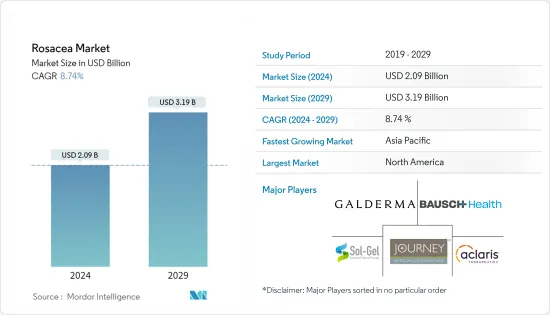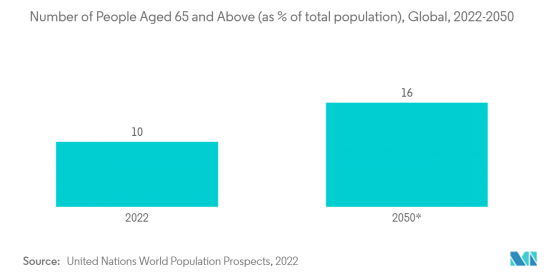
|
市場調査レポート
商品コード
1404502
酒さの市場シェア分析、産業動向と統計、2024年~2029年の成長予測Rosacea - Market Share Analysis, Industry Trends & Statistics, Growth Forecasts 2024 - 2029 |
||||||
カスタマイズ可能
適宜更新あり
|
|||||||
| 酒さの市場シェア分析、産業動向と統計、2024年~2029年の成長予測 |
|
出版日: 2024年01月04日
発行: Mordor Intelligence
ページ情報: 英文 112 Pages
納期: 2~3営業日
|
全表示
- 概要
- 目次
酒さの市場規模は2024年に20億9,000万米ドルと推定され、2029年には31億9,000万米ドルに達すると予測され、予測期間(2024~2029年)のCAGRは8.74%で成長する見込みです。

COVID-19はパンデミック期に市場の成長に大きな影響を与えました。これは主に、COVID-19保護キットによる酒さの状態の悪化によるものです。
例えば、2021年2月に発表された記事によると、Galdermaが実施した調査では、パンデミックはマスク着用に関連する徴候や症状の悪化によって酒さ患者に影響を与える可能性があり、ヘルスケア専門家の診察が減少したことが示唆されました。このように、COVID-19の流行による酒さ治療の需要は、パンデミック期間中の市場の成長に寄与しました。しかし、パンデミックは沈静化したため、予測期間中、調査対象市場は全般的に成長すると予想されます。
市場の成長は、世界人口の間で酒さの有病率が増加していることなどが要因となっています。例えば、2021年12月にInternational Journal of Dermatologyが発表した論文では、調査参加者の2.1%が酒さに罹患していると言及されています。酒さの有病率は年齢とともに有意に増加しました。この報告書はまた、酒さは65歳以上に最も多く見られる一般的な皮膚疾患であることにも言及しています。
さらに、2021年10月に発表された世界保健機関(WHO)のデータによると、7年後には世界の6人に1人が60歳以上になると推定されています。60歳以上の人口に占める割合は14億人に増加します。世界の60歳以上人口は27年後に倍増(21億人)します。80歳以上の人口は27年後には3倍の4億2,600万人に達すると予想されています。このように、世界の老人人口の増加が酒さ治療市場の成長を後押しすることも予想されます。
さらに、主要市場企業による開発の高まりも、市場の成長を後押しすると予想されます。 例えば、2021年6月、Sol-Gel TechnologiesとGaldermaは、米国におけるEpsolayとTwyneoの商業化に関する2つの5年間の独占ライセンス契約の締結を発表しました。
そのため、普及率の上昇に伴い、医師や学会の認識も高まり、この市場の需要をさらに押し上げています。しかし、関連症状を抑えるジェネリック医薬品の存在が酒さ市場の成長を妨げています。
酒さ市場の動向
予測期間中、抗生物質セグメントが大きな市場シェアを占める見込み
抗生物質は酒さの症状の治療薬として長期にわたって処方されてきました。ニキビの数を減らし、ニキビ周辺の細菌の炎症や赤みを抑えることができます。抗生物質には、経口抗生物質と局所抗生物質の2種類があります。
テトラサイクリン、ドキシサイクリン、ミノサイクリンなどの経口抗生物質は、酒さの細菌成分をコントロールし、炎症を抑える効果があることが証明されています。例えば、2022年6月に国立生物工学情報センター(NCBI)が更新した論文によると、ドキシサイクリンは酒さによる吹き出物や瘤の治療にのみ使用されます。この病気から早期に解放されるために、医師や医者によって最も一般的に好まれています。それでも、それは通常、他のサブセグメントよりもこのセグメントの売上を牽引する長期的なものです。そのため、酒さの治療における抗生物質の使用量の多さが市場成長の主な要因となっています。
さらに、2021年8月にNCBIによって更新された論文では、メトロニダゾールは酒さの治療に使用される抗生物質クリームまたはゲルです。この研究では、メトロニダゾールを定期的に使用した患者の酒さ関連の膿疱や丘疹が40%から65%減少したことも述べられています。このような酒さ関連の皮膚症状の軽減は、研究セグメントの成長に寄与すると予想されます。さらに、酒さは高齢者によく見られるため、高齢者人口の増加もこのセグメントの成長を促進する主な要因です。このように、老人人口の増加や酒さ治療における抗生物質の高い有効性といった上記の要因は、予測期間にわたって調査セグメントの成長を促進すると予想されます。

北米は予測期間中市場で大きなシェアを占めると予想される
北米には、この市場の成長を支える複数の要因があります。その要因には、医薬品や医療機器に対する政府による毎年の高いヘルスケア支出や、社会における意識などがあります。
例えば、全米酒さ協会が2021年に更新したデータによると、全米酒さ協会は、この潜在的に深刻な疾患について一般の人々を教育するために、4月を酒さ啓発月間として設計しました。さらに、2021年9月に発表された米国皮膚科学会が更新したデータによると、約1,600万人のアメリカ人が酒さに苦しんでおり、おそらく数百万人が一時的な寛解状態にあります。
さらに、各社は、有利な規制要件のため、米国で最初に製品を発売することを好んでおり、これがこの市場の需要を促進しています。例えば、2022年4月、ソル・ジェル・テクノロジーズ社は、成人の酒さの炎症性病変の治療薬として、過酸化ベンゾイル5%の独自クリーム製剤である医薬品EPSOLAYのFDA(食品医薬品局)承認を取得しました。エプソレイに含まれる過酸化ベンゾイルは、シリカベースの特許マイクロカプセルに内包されています。このシリカベースの殻は、過酸化ベンゾイルが時間をかけてゆっくりと放出されるように設計されており、良好な有効性と安全性プロファイルを提供します。
同様に、2022年6月、ガルデルマ社は、米国食品医薬品局(FDA)の承認を受け、米国でエプソレイ(過酸化ベンゾイル)クリーム5%を発売すると発表しました。エプソレイクリームはマイクロカプセル化された過酸化ベンゾイル(E-BPO)外用剤で、酒さの凸凹やシミを緩和することが証明されており、迅速かつ顕著で持続的な緩和をもたらします。
このように、酒さに対する意識の高まりや大手企業による開発の増加など、上記のような要因が、予測期間にわたってこの地域の市場成長を促進すると予想されます。
酒さ産業の概要
酒さ市場は、世界的および地域的に事業を展開する少数の企業の存在により、その性質上、適度に統合されています。酒さ市場では、主に先進国市場全体で大手企業間の競争が激化しています。 主な市場参入企業には、Bausch Health Companies Inc.、Galderma、LEO Pharma A/S、Journey Medical Corporation(Fortress Biotech, Inc.)、Aclaris Therapeuticsなどがあります。
その他の特典:
- エクセル形式の市場予測(ME)シート
- 3ヶ月間のアナリスト・サポート
目次
第1章 イントロダクション
- 調査の前提条件と市場定義
- 調査範囲
第2章 調査手法
第3章 エグゼクティブサマリー
第4章 市場力学
- 市場概要
- 市場促進要因
- 酒さの発生率と有病率の増加
- 配合剤への志向の高まり
- 市場抑制要因
- ジェネリック医薬品の使用増加
- ポーターのファイブフォース分析
- 供給企業の交渉力
- 買い手/消費者の交渉力
- 新規参入業者の脅威
- 代替品の脅威
- 競争企業間の敵対関係の強さ
第5章 市場セグメンテーション(市場規模- 金額ベース)
- 薬剤クラス別
- 抗生物質
- アルファ作動薬
- レチノイド
- 副腎皮質ホルモン
- 免疫抑制剤
- その他の薬剤クラス別
- 投与方法別
- 局所
- 経口
- 地域別
- 北米
- 米国
- カナダ
- メキシコ
- 欧州
- ドイツ
- 英国
- フランス
- イタリア
- スペイン
- その他欧州
- アジア太平洋
- 中国
- 日本
- インド
- オーストラリア
- 韓国
- その他アジア太平洋地域
- 中東・アフリカ
- GCC
- 南アフリカ
- その他中東とアフリカ
- 南米
- ブラジル
- アルゼンチン
- その他南米
- 北米
第6章 競合情勢
- 企業プロファイル
- Aclaris Therapeutics
- Amorepacific Corporation
- Bausch Health Companies Inc.
- Hovione FarmaCiencia SA
- LEO Pharma A/S
- Galderma
- Journey Medical Corporation(Fortress Biotech, Inc.)
- Tarsus Pharmaceuticals, Inc.
- Zydus Group
- Sol-Gel Technologies Ltd.
第7章 市場機会と今後の動向

The Rosacea Market size is estimated at USD 2.09 billion in 2024, and is expected to reach USD 3.19 billion by 2029, growing at a CAGR of 8.74% during the forecast period (2024-2029).
COVID-19 had a significant impact on the growth of the market during the pandemic period. This is mainly due to the worsening of the rosacea condition due to the COVID-19 protection kits.
For instance, according to the article published in February 2021, a survey conducted by Galderma suggested that the pandemic may impact rosacea patients by worsening of signs and symptoms related to mask-wearing, and there were reduced healthcare professional consultations. Thus, the demand for rosacea treatment due to the COVID-19 outbreak contributed to the market's growth during the pandemic period. However, the pandemic has subsided, so the studied market is expected to grow generally during the forecast period.
The growth of the market is attributed to factors such as the increasing prevalence of rosacea among the global population. For instance, the article published by the International Journal of Dermatology in December 2021 mentioned that 2.1% of the survey participants had rosacea. The prevalence of rosacea increased significantly with age. The report also mentioned that Rosacea is a common skin condition most prevalent above the age of 65.
Moreover, according to World Health Organization (WHO) data published in October 2021, it is estimated that 1 in 6 people worldwide will be aged 60 years or over, in seven years. The share of the population aged 60 years and over will increase to 1.4 billion. The world's population of people aged 60 years and older will double (2.1 billion) in 27 years. The number of persons aged 80 or older is expected to triple in 27 years to reach 426 million. Thus, the rising geriatric population worldwide is also expected to boost the growth of the rosacea treatment market.
Moreover, the rising developments by major market players are also expected to boost market growth. For instance, in June 2021, Sol-Gel Technologies and Galderma announced the signing of two exclusive five-year license agreements for the commercialisation of Epsolay and Twyneo in the United States.
Therefore, with rising prevalence, the awareness among physicians and societies has also increased, further driving the demand for this market. However, the presence of generic drugs to curb the related symptoms hinders the growth of the rosacea market.
Rosacea Market Trends
Antibiotics Segment is Expected to Have a Significant Market Share During the Forecast Period
Antibiotics have been prescribed as a treatment for the symptoms of rosacea for an extended period. It can reduce the number of acne pimples and bacterial inflammation or redness around the acne pimples. Antibiotics are available in two forms, including oral antibiotics and topical antibiotics.
Oral antibiotics, such as tetracycline, doxycycline, and minocycline, have been proven to control rosacea's bacterial component and have inflammatory benefits. For instance, according to the article updated by the National Center for Biotechnology Information (NCBI) in June 2022, doxycycline is used only to treat pimples and bumps caused by rosacea. It is most commonly preferred by physicians and doctors for early relief from the disease. Still, it is usually for an extended period, which drives this segment's sales over other sub-segments. So, the high usage of antibiotics for the treatment of rosacea is the main factor for the growth of the market.
Furthermore, in the article updated by NCBI in August 2021, metronidazole is an antibiotic cream or gel used to treat rosacea. The study also mentioned that patients who regularly used metronidazole saw their rosacea-related pustules and papules by between 40% and 65%. Such reduction of rosacea-related skin conditions is expected to contribute to the growth of the studied segment. Moreover, as rosacea is often common in older people, the rising geriatric population is also a major factor driving the segment growth. Thus, the above-mentioned factors, such as the rising geriatric population and the high efficacy of antibiotics in rosacea treatment, are expected to drive the growth of the studied segment over the forecast period.

North America is Expected to Hold a Significant Share in the Market Over the Forecast Period
North America has multiple factors which support the growth of this market. Some factors include high healthcare expenditure by the government each year on pharmaceuticals and medical devices and awareness in society.
For instance, according to the data updated by The National Rosacea Society in 2021, the National Rosacea Society designed April as Rosacea Awareness Month to educate the public on this potentially serious disorder. Moreover, as per the data updated by the American Academy of Dermatology published in September 2021, about 16 million Americans suffer from rosacea, and maybe millions more are in temporary remission.
Moreover, the companies also prefer to release their products first in the United States due to favorable regulatory requirements, which drive the demand for this market. For instance, in April 2022, Sol-Gel Technologies, Ltd. received the Food and Drug Administration (FDA) approval of its drug product, EPSOLAY, a proprietary cream formulation of benzoyl peroxide, 5%, for the treatment of inflammatory lesions of rosacea in adults. The benzoyl peroxide in EPSOLAY is encapsulated within silica-based patented microcapsules. The silica-based shell is designed to slowly release benzoyl peroxide over time to provide a favorable efficacy and safety profile.
Similarly, in June 2022, Galderma announced the availability of EPSOLAY (benzoyl peroxide) cream, 5%, in the United States following approval by the United States Food and Drug Administration (FDA). EPSOLAY Cream is a microencapsulated benzoyl peroxide (E-BPO) topical treatment proven to relieve the bumps and blemishes of rosacea and provides rapid, significant and sustained relief.
Thus, the factors mentioned above such as the rising awareness about rosacea and the increasing developments by major players, are expected to drive the growth of the market in this region over the forecast period.
Rosacea Industry Overview
The rosacea market is moderately consolidated in nature due to the presence of a few companies operating globally as well as regionally. The rosacea market has observed growing competition among leading players, majorly across the developed markets. Some of the major market players include Bausch Health Companies Inc., Galderma, LEO Pharma A/S, Journey Medical Corporation (Fortress Biotech, Inc.), and Aclaris Therapeutics, among others.
Additional Benefits:
- The market estimate (ME) sheet in Excel format
- 3 months of analyst support
TABLE OF CONTENTS
1 INTRODUCTION
- 1.1 Study Assumptions and Market Definition
- 1.2 Scope of the Study
2 RESEARCH METHODOLOGY
3 EXECUTIVE SUMMARY
4 MARKET DYNAMICS
- 4.1 Market Overview
- 4.2 Market Drivers
- 4.2.1 Increasing Incidence and Prevalence of Rosacea
- 4.2.2 Increasing Inclination Toward Combination Products
- 4.3 Market Restraints
- 4.3.1 Increased Use of Generic Drugs
- 4.4 Porter's Five Forces Analysis
- 4.4.1 Bargaining Power of Suppliers
- 4.4.2 Bargaining Power of Buyers/Consumers
- 4.4.3 Threat of New Entrants
- 4.4.4 Threat of Substitute Products
- 4.4.5 Intensity of Competitive Rivalry
5 MARKET SEGMENTATION (Market Size by Value - USD)
- 5.1 By Drug Class
- 5.1.1 Antibiotics
- 5.1.2 Alpha Agonists
- 5.1.3 Retinoid
- 5.1.4 Corticosteroids
- 5.1.5 Immunosuppressants
- 5.1.6 Other Drug Classes
- 5.2 By Mode of Administration
- 5.2.1 Topical
- 5.2.2 Oral
- 5.3 Geography
- 5.3.1 North America
- 5.3.1.1 United States
- 5.3.1.2 Canada
- 5.3.1.3 Mexico
- 5.3.2 Europe
- 5.3.2.1 Germany
- 5.3.2.2 United Kingdom
- 5.3.2.3 France
- 5.3.2.4 Italy
- 5.3.2.5 Spain
- 5.3.2.6 Rest of Europe
- 5.3.3 Asia-Pacific
- 5.3.3.1 China
- 5.3.3.2 Japan
- 5.3.3.3 India
- 5.3.3.4 Australia
- 5.3.3.5 South Korea
- 5.3.3.6 Rest of Asia-Pacific
- 5.3.4 Middle East and Africa
- 5.3.4.1 GCC
- 5.3.4.2 South Africa
- 5.3.4.3 Rest of Middle East and Africa
- 5.3.5 South America
- 5.3.5.1 Brazil
- 5.3.5.2 Argentina
- 5.3.5.3 Rest of South America
- 5.3.1 North America
6 COMPETITIVE LANDSCAPE
- 6.1 Company Profiles
- 6.1.1 Aclaris Therapeutics
- 6.1.2 Amorepacific Corporation
- 6.1.3 Bausch Health Companies Inc.
- 6.1.4 Hovione FarmaCiencia SA
- 6.1.5 LEO Pharma A/S
- 6.1.6 Galderma
- 6.1.7 Journey Medical Corporation (Fortress Biotech, Inc.)
- 6.1.8 Tarsus Pharmaceuticals, Inc.
- 6.1.9 Zydus Group
- 6.1.10 Sol-Gel Technologies Ltd.


